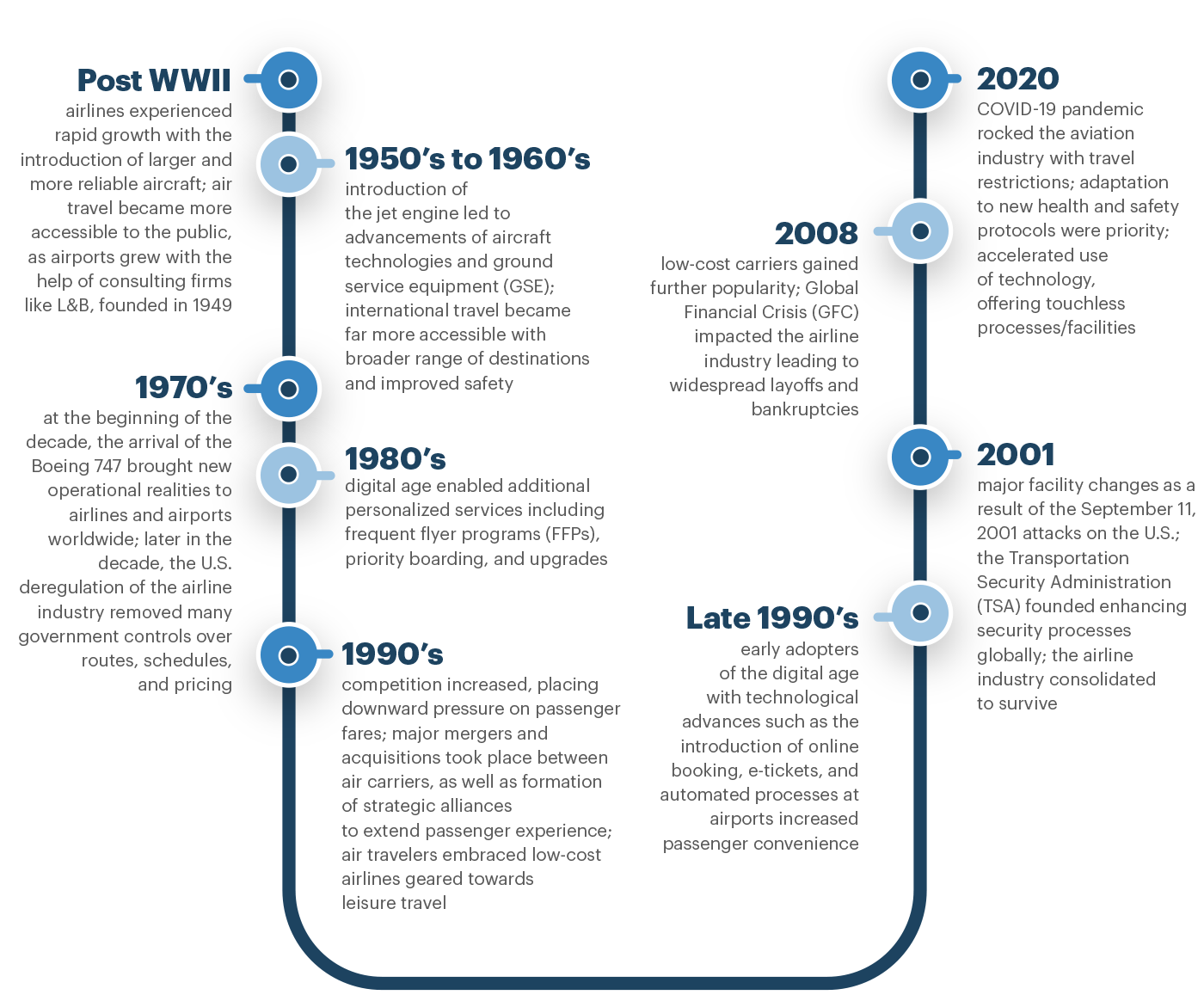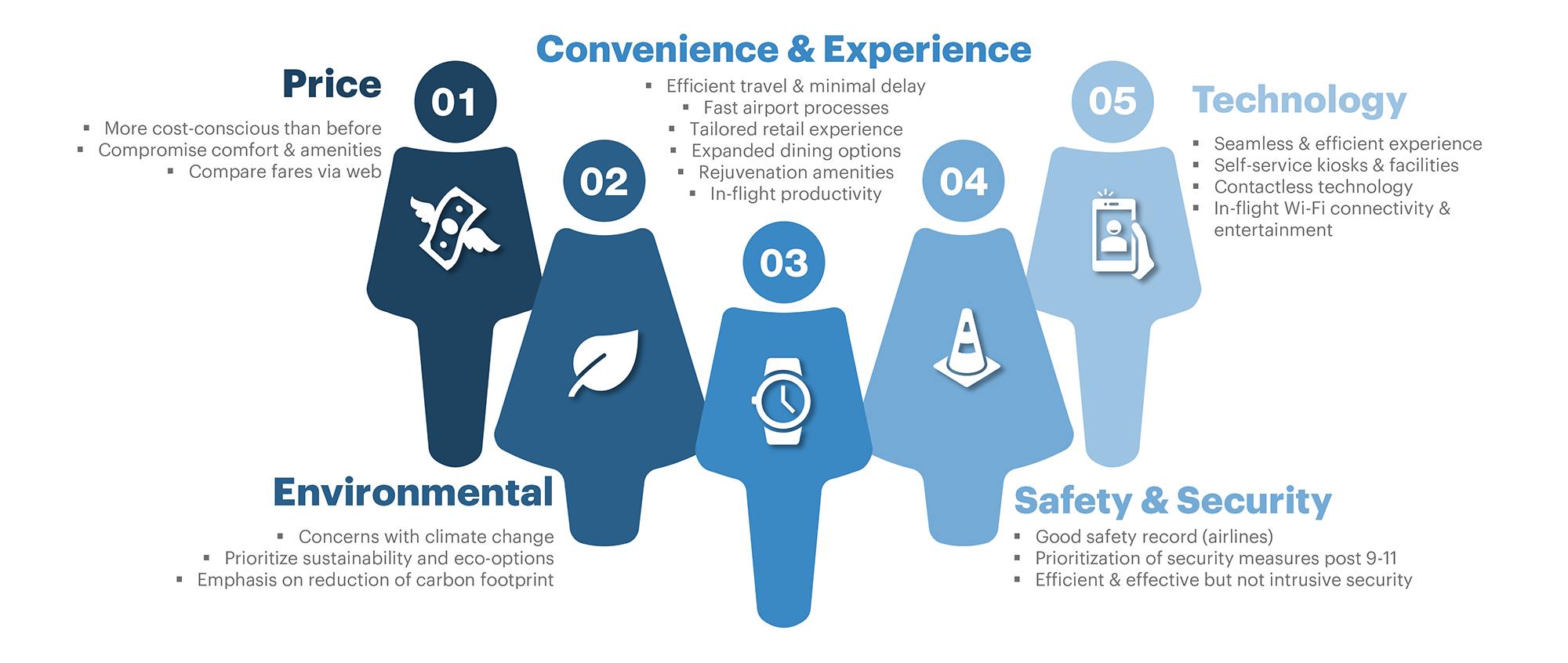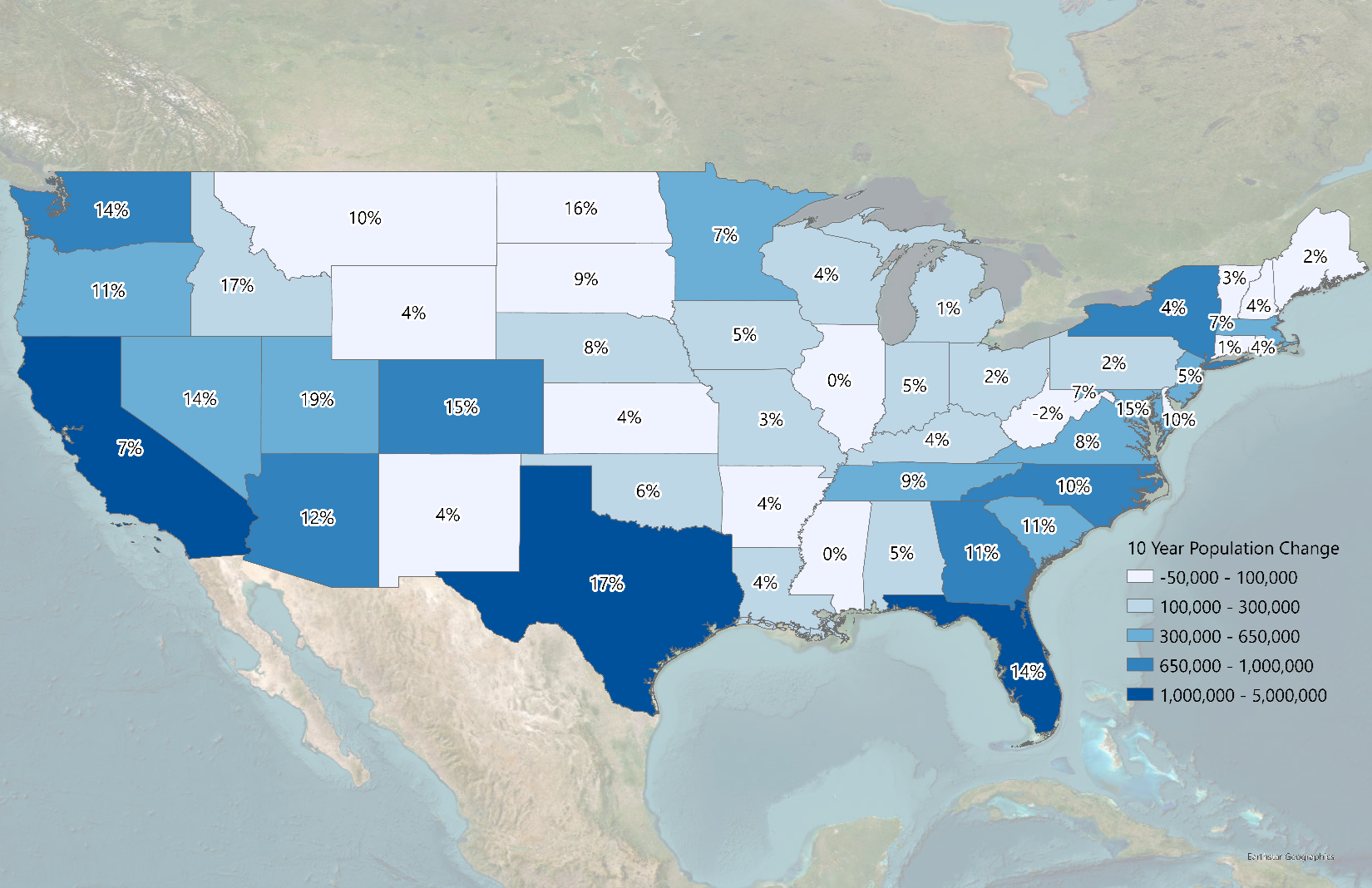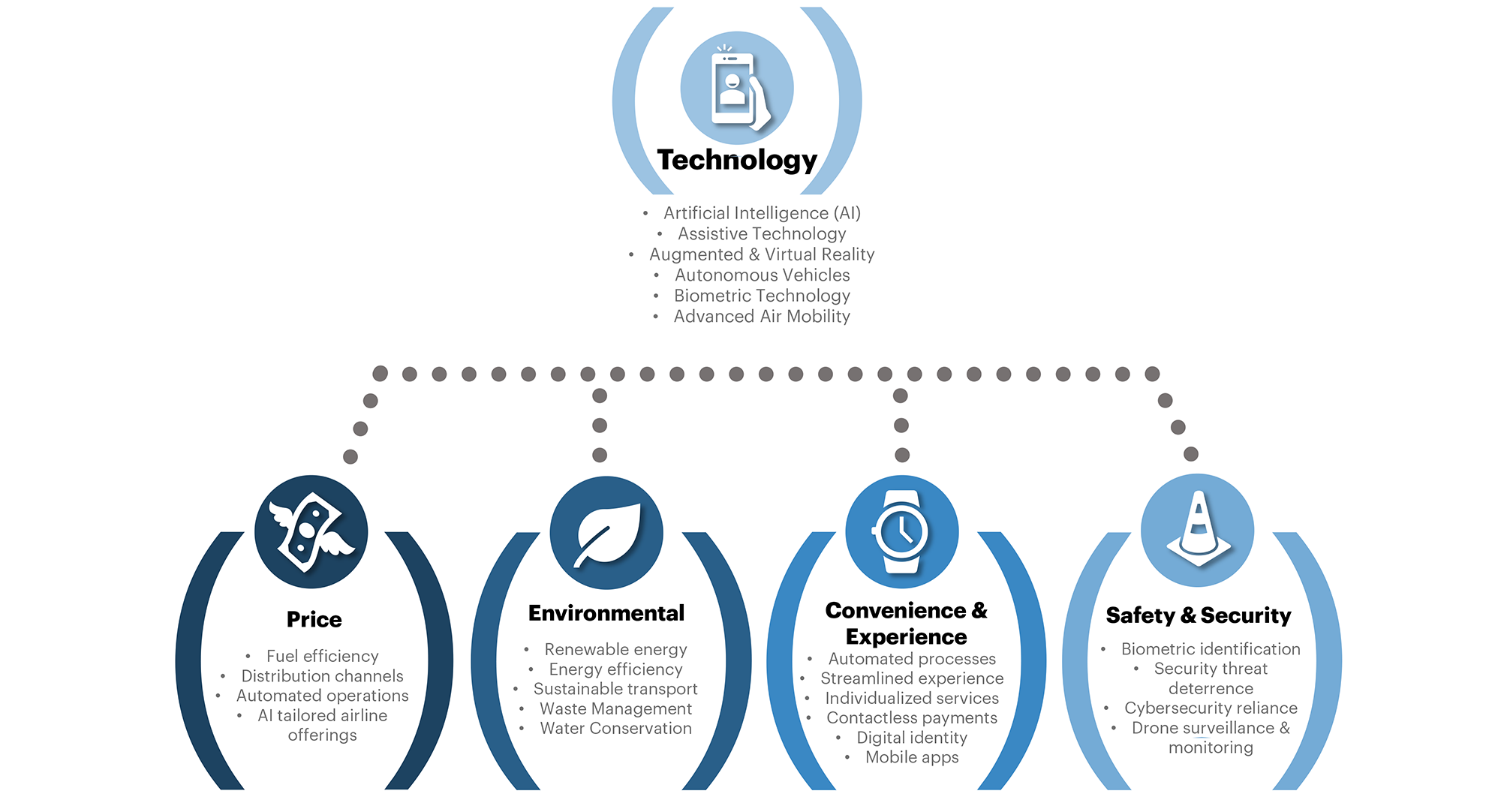The Future of the Air Passenger
Author: Lisa Schafer
Other Credits: Rich Barone, Ria DeJong
Share This Story:
The aviation industry has come a long way since its inception in the early 20th century and with that, the evolution of the air passenger. This article explores that evolution, beginning with the early days of commercial aviation through today and envisions how the future could unfold including how changing passenger demographics and behaviors will influence the growth and shape of markets.
History of the Air Passenger
Passenger needs and preferences have evolved since the early days of commercial aviation. In the early 1900s, air travel has transformed from basic ticket counters and waiting areas on the apron to the development of terminal facilities resembling luxury shopping malls. A brief history on the impacts of the industry is depicted in the following timeline.
The Evolution of Commercial Aviation

Source: Landrum & Brown, 2023.
Today’s Passengers
There are five factors – price, convenience & experience, technology, environmental, safety & security – that we believe influence the preferences of today’s air travelers. Airports and airlines that understand these factors and prioritize the needs and preferences of their passengers will be more likely to succeed in this highly competitive industry. These factors can individually carry more influence than others depending on the location of the airport, socioeconomic events (e.g., COVID-19 pandemic), as well as passenger characteristics such as age, generation, and wealth.
The five key factors that influence passengers and drive passenger behaviors are illustrated in the below graphic.
Existing Passenger Influences and Drivers

Source: Landrum & Brown, 2023.
Close attention to these five factors by industry professionals (planners and engineers) has led to increased functionality and design of airport facilities. Airports have become colossal complexes focused on fulfilling each of these key factors for passengers. All five of these key factors have contributed to industry advancements. Understanding historical trends and current factors that influence passenger behavior are critical to airport planning for future facilities.
Tomorrow’s Passengers
Predicting the characteristics that will define the future airline passenger is difficult as it will depend on a variety of considerations, which can be categorized into three main areas of passenger influence:
- Demographics
- Technology
- Economic and Societal Shifts
Many of the key factors seen today in passengers will carry forward into the future while others will continue to evolve.
Demographics
While it is challenging to predict specific geographical population growth patterns, airport development has significantly impacted population growth in many regions, particularly in geographies previously isolated or difficult to access. And population is growing overall.
The population of the U.S. has grown by 8% from 307 million residents in 2011 to 330 million residents in 2021 with many states seeing double digit percentage growth over the last decade. During the same period, the world population has increased at an even faster rate, by approximately 12%.
U.S. Population Growth (2011 to 2021)

Sources: United States Census Bureau. American Community Survey Demographic and Housing Estimates 2011 to 2021 (Table DP05). Retrieved from https://www.data.census.gov. Accessed April 2023. Landrum & Brown, 2023.
Given these growth trends, it is important for airports and airlines to consider the evolving social, technological, and geographical needs of their passengers. The changing nature of the world’s population will be a significant driver of airport growth and passenger travel demand. Evolving urbanization and larger elderly populations that require special services are prime examples of shifts that could lead to travel preference changes.
Population growth and urbanization patterns are predicated by a complex set of social, economic, and environmental factors, which dictate geographical population distributions globally. Even though technological advancements such as remote work and virtual communications appears to have renewed (in the U.S., in particular) a shift away from urban centers in recent years – a trend that started after WWII but began to slow at the turn of the century, other factors such as climate change and natural disasters may make some areas less habitable in the future, particularly coastal regions. Globally, urbanization is predicted to continue its rise as more people around the world move from rural areas in search of better economic opportunities and quality of life. All of that put together makes the prediction murky, but the certainty is the constant change affecting which airports passengers choose and where demand will rise or fall.
The U.S. along with other countries, will continue to experience a demographic shift due to the aging population. As stated in the L&B LAB from May of 2022, Aging and Aviation, two billion persons will be over the age of 60 by 2050, estimating a daily retirement count at 10,000 citizens annually over the next decade in the U.S. alone. These individuals are healthier and travel more than previous generations; however, they don’t have the same wants and desires as those who came before them – they are less inhibited in their spending and have a desire to travel more.
Baby boomers (born 1946-1964) have more time and wealth to spare than younger generations and have differing values that will impact their decisions on air travel. Providing amenities at airports attuned to the needs of these individuals will be key. Regions where aging populations are higher, typically warmer weather climate areas, will need to ensure facilities can accommodate this influx of passengers. Investing in their wants and purchasing habits will also prove beneficial to industry stakeholders offering tailored services for these individuals.
The younger generations: Millennials (born 1981-1996), Generation Z (born 1997-2012), and soon Generation Alpha (born 2013-2025) will also continue to influence future passenger trends as these generations seek out and spend more on personalization and value-added services such as entertainment, loyalty programs, lounge access, technology features, and eco-friendly options. In the U.S. Millennials and Generation Z make up 30 percent of the annual household spending. As younger generations become wage earners, they are allocating more to their transportation spending than previous generations even though they have lower overall incomes.
The evolution of generational characteristics, along with population shifts have the potential to impact future airport growth globally. Regardless of the generation, demographics will play a large role that will be unique to each region or airport based on the surrounding population. These factors will impact airport efficiency and passenger level of service.

Source: Landrum & Brown, 2023.
Technology
New technological advancements, including reemerging technologies like supersonic commercial flights, will play a major role in the evolution of the aviation industry, and that’s only escalating. Over the next 10 to 20 years, technology will shape the industry in many ways, and this will impact how passengers perceive air travel. Technology is expected to be a key driver of the other four factors (price, environmental, convenience, and safety and security) as outline below.
Key Technologies and Influences

Source: Landrum & Brown, 2023.
Artificial Intelligence (AI) has the potential to revolutionize the airport industry and improve the future passenger experience, impacting all key factors that influence passengers.
AI can contribute to environmental sustainability in several ways. AI-powered optimization algorithms can enhance flight planning, leading to more fuel-efficient routes and reduced carbon emissions. Predictive maintenance systems can detect and address aircraft issues proactively, minimizing unscheduled maintenance and reducing waste. AI-powered systems can monitor equipment and identify potential issues before they become critical, allowing for proactive maintenance and reducing the risk of flight delays.
AI can improve baggage handling processes, reducing the risk of lost luggage and delays. AI-powered systems can track baggage from check-in to arrival and optimize baggage handling processes.
Passengers can use AI for personalized customer service, accessing tailored information, making reservations, and receiving real-time assistance through chatbots and virtual assistants.
In safety and security, AI enhances airport security by analyzing data and identifying potential threats in real-time. AI-powered systems monitor CCTV cameras and detect suspicious behavior, preventing security incidents.
Assistive Technology increasingly affects the convenience, safety, and security factors that influence passengers, and will be critical in transforming the travel experience for elderly people and people with disabilities making airports more accessible and inclusive. Smart wheelchairs equipped with sensors, cameras, and connectivity features can help people with disabilities navigate the airport easily. Wearable technology, such as smartwatches and bracelets, can provide real-time information on airport navigation and services to people with disabilities – haptic feedback or audio instructions could be used to guide passengers through the airport.
Augmented and Virtual Reality can provide enhanced, interactive, and immersive experiences for all passengers, including people with disabilities. These technologies can simulate airport environments and provide real-time information on airport navigation and services. Smart assistive apps can provide customized support to people with disabilities, such as real-time navigation assistance, alerts on changes to flight schedules, and personalized communication with airport staff.
Autonomous Vehicles, such as self-driving shuttles and baggage carts, are expected to become more common in airports in the years to come. These vehicles can transport passengers and baggage between airport facilities, reducing congestion and improving efficiency. These vehicles would automate tasks such as cleaning, maintenance, and baggage handling.
Biometric Technology, such as facial recognition and fingerprint scanning, is already utilized in some airports for security and immigration purposes. In the future, biometric technology is expected to become more widespread under the IATA One ID initiative, with passengers being able to use biometric identification to check-in, go through security, and even board flights.
Advanced Air Mobility (AAM) such as electric vertical takeoff and landing (eVTOL) vehicles and autonomous aircraft, have the potential to offer faster, more convenient, and direct transportation options, bypassing traditional ground transportation challenges along with enhancing accessibility to remote areas.
Additionally, AAM could alleviate congestion at airports by diverting some short-haul conventional aircraft operations, leading to smoother operations and potentially more personalized and streamlined services for passengers.
It’s important to note that the pace of these technological advancements and their implementation may vary across airlines, airports, and regions impacting passengers at different times and in many different ways. However, these anticipated advancements highlight the potential ways in which technology can transform the future passenger experience.
Economic and Societal Shifts
Economic and societal shifts will also have a significant impact on the future passenger. Regulatory policies (including safety and security), economic factors, taxation policies, and trade agreements, will all affect the future passenger.
Changes in regulatory policies will impact the airline industry in many ways. For example, policies related to greenhouse gas emissions will change airline operational procedures and increase ticket prices. These policies in turn will change passenger air travel frequency through greater environmental awareness or higher ticket prices. Regulatory policies related to security resulted in drastic changes in passenger travel patterns and attitudes over the last 20 years. Security policies will continue to evolve with new and evolving technology. These policies will impact passenger and baggage screening procedures, baggage contents regulations, and other security measures in and around airports.
Additionally, taxation policies, such as airport taxes or fuel taxes, will affect the cost of air travel for passengers. Taxation policies can impact ticket pricing and profitability depending upon whether airlines add the cost of new taxes to fares. This, in turn, affects passenger behavior and travel patterns.
Economic shifts, caused by recessions, inflation, or extreme events (natural or manmade), will continue to shape air passenger activity and attitudes. Future economic factors will also affect the pricing, destination popularity, and availability of air travel, which will influence passenger behavior and travel choices.
Passenger behavior and travel patterns may also change with liberalization of air transport markets by increases in competition and changes to ticket prices and trade agreements. New trade agreements often change the airline industry in many ways, such as by affecting market access, air service agreements, and competition policies. Alternatively, global conflicts like the war in Ukraine dampens travel demand, in this case closing air travel markets to Russia and limited access to trans-polar air routes between South and East Asia and the European Union and the U.S. The war has also changed world trade relationships, which changes business travel patterns, reducing demand in some markets while increasing demand in others.
To respond to these economic and societal shifts, airports should embrace resiliency Planning (See L&B LAB from April 20, 2021, Airport Resiliency) to be better prepared to adapt to many of these coming trends. Economic stressors, such as the recent pandemic and other extreme weather events, are likely to continue over the coming decades. As governments respond to these global challenges, their actions may incur costs and requirements. While the specifics of future socioeconomic landscape remains unclear, airport resiliency plans will enable airports to harden their facilities and finances to face tomorrow’s challenges and continue serving their passengers.
Final Thoughts
The behaviors and desires of air passengers have evolved substantially over the last century, driving the development of airports along the way. The airport industry will need to keep pace with societal and technological change that will influence air passenger wants and needs – which will be challenging. Airports that conduct passenger market assessments will find much success in determining how to grow and cater to the unique wants and needs of the passengers they serve. Airports and the aviation industry must also become more resilient so they are able to adapt/respond to many of the challenges they will face over the coming decades.
What is the L&B LAB?
The LAB is Landrum & Brown’s research and development unit. Our mission is to harness decades worth of industry knowledge and expertise to develop innovative solutions that support our clients along with promoting industry thought leadership.
This document was prepared by Landrum & Brown, Inc. | Richard.Barone@landrumbrown.com
Sign up to receive our next L&B LAB in your inbox!



